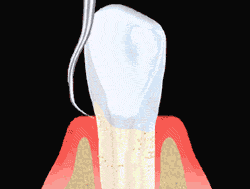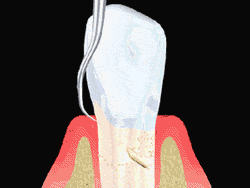How is Gum Disease Treated?
Periodontal disease is a bacterial infection that penetrates into the gums and into the bone around your teeth, causing inflammation. Periodontal inflammation leads to bone loss, and possibly tooth loss, and may contribute to other serious medical conditions.
The periodontal infection must be removed and the area given a chance to heal. There are generally two levels of treatment for this condition depending upon the severity of your infection.
Early Periodontitis
Many times, the early stages of periodontal disease are best treated with non surgical therapy in the form of scaling and root planing. This may eliminate the need for further therapy, including surgery.
 Scaling
Scaling
 Root Planing
Root Planing
The initial stage of treatment is usually a thorough cleaning that may include scaling to remove plaque and calculus deposits beneath the gum line. Deposits below the gums are removed and the tooth root surfaces are smoothed allowing the gum tissue to heal. In some cases, the occlusion (bite) may require adjustment.
In rare instances antibiotics or irrigation with anti-microbials (chemical agents or mouth rinses) may be recommended to help control the growth of bacteria that create toxins and cause periodontitis.
The goal of scaling and root planing is to control the inflammation (infection) of periodontal disease, prior to assessing the damage to the tissues. This is analogous to a fireman putting out a house fire prior to you calling a contractor to evaluate the damage of the fire and develop a plan to correct this damage.
Moderate to Advanced Periodontitis
If your infection has spread into the bone that supports your teeth and is below the level that can be reached, then a surgical procedure can be performed to retract the gums and remove the deeper infection.
When periodontal disease reaches this lower level, it dissolves the bone around the teeth and can lead to bone loss. Once the infection has been removed, we repair the damaged area with a procedure called Bone Grafting.





